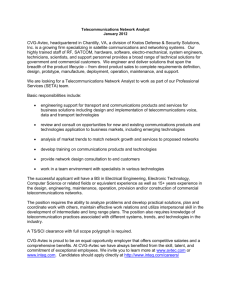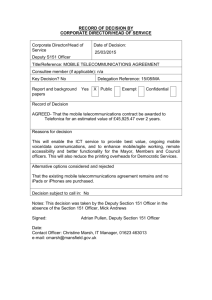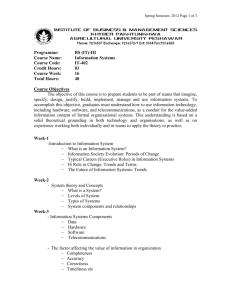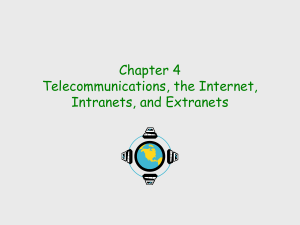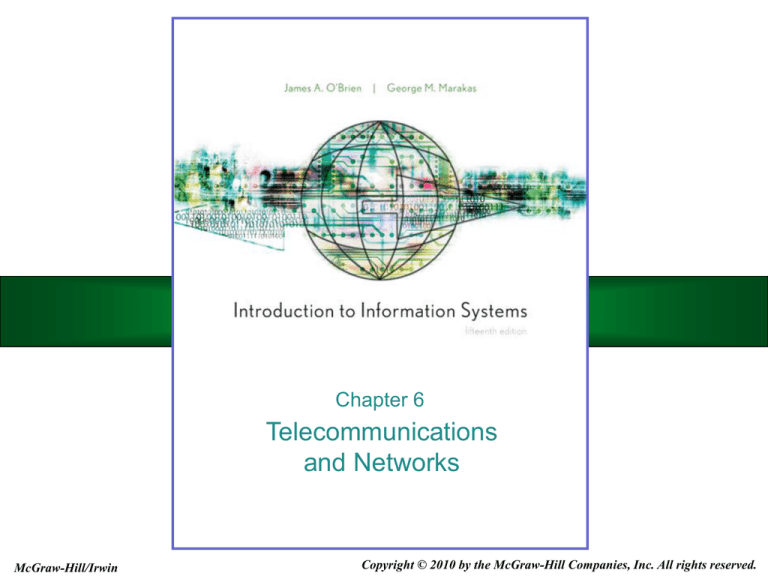
Chapter 6
Telecommunications
and Networks
McGraw-Hill/Irwin
Copyright © 2010 by the McGraw-Hill Companies, Inc. All rights reserved.
Learning Objectives
Understand the concept of a network
Apply Metcalfe’s law in understanding the
value of a network
Identify major developments and trends in
the industries, technologies, and business
applications of telecommunications and
Internet technologies
Provide examples of the business value of
Internet, intranet, and extranet applications
6-2
Learning Objectives
Identify the basic components, functions,
and types of telecommunications networks
used in business
Explain the functions of major components
of telecommunications network hardware,
software, media, and services
Explain the concept of client/server
networking
Understand the two forms of peer-to-peer
networking
6-3
Learning Objectives
Explain the difference between digital and
analog signals
Identify the various transmission media and
topologies used in telecommunications
networks
Understand the fundamentals of wireless
network technologies
Explain the concepts behind TCP/IP
Understand the seven layers of the OSI
network model
6-4
Case 1: Starbucks and Others
Wi-Fi hot spots
– Emerged due to fast-growing popularity of laptops
– Wi-Fi coffee shops supplanted cybercafés, which relied
on the expensive purchase and upkeep of PCs
Public Wi-Fi access is at crossroad
– Recent moves toward free and advertising-based
Wi-Fi service by Starbucks and others
– Web advertising can offset costs or make money
Like television, Wi-Fi is increasingly given away
in exchange for ads
6-5
Case Study Questions
Do you agree with the plans by Starbucks
to offer time-limited free Wi-Fi to customers?
– Part of the idea is to push the Starbucks card
and reap other business benefits from doing
so. Do you think free Wi-Fi is enough to instill
that kind of loyalty?
– Based on the experiences of the other coffee
houses, do you think free access was a critical
factor in developing a loyal customer base?
6-6
Case Study Questions
Part of the reason for Starbucks’ move
had to do with increased competition from
chains like McDonald’s for the morning
breakfast crowd. However, Starbucks and
McDonald’s hardly seem to be targeting
the same public
– Do you think that free wireless access by
such a competitor would have moved a
significant portion of Starbucks customers
away?
6-7
Case Study Questions
Some companies offer free Wi-Fi in
exchange for viewing advertisements or
answering questions for market research
studies
– Would you be willing to do so in order to get
free wireless access, say, at an airport?
– Would your answer change if you were using
a corporate laptop versus your own, because
of security concerns?
6-8
Network Concepts
A network is an interconnected or interrelated
chain, group, or system
The number of possible connections on a
network is N(N–1) or N2 –N
N = number of nodes (points of connection)
10 computers on a network = 10(10–1) =
10x9 = 90 possible connections
6-9
Metcalfe’s Law
The usefulness (utility) of a network equals
the square of the number of users
The more users on a network,
the more useful it becomes
Until critical mass is reached, a change in technology
only affects the technology
Once critical mass is attained, social, political, and
economic systems change
Ex: The Internet is growing exponentially.
We can expect more value, for less cost,
virtually every time we log on
6-10
Telecommunication Trends
6-11
Telecommunications-Based Services
6-12
Internet Networking Technologies
Internet networking technologies are being
used as a technology platform
– Web browser suites
– HTML Web page editors
– Network management software
– Firewalls
Being applied in Internet, intranet, and
extranet applications
Reinforces previous move toward client/server
networks based on open-systems architecture
6-13
Open Systems
Open systems use common standards
for hardware, software, applications,
and networks
– Internet networking technologies are a
common standard for open systems
Connectivity
– Open systems provide greater connectivity
and network interoperability
– Middleware may be needed to help diverse
systems work together
6-14
Middleware
Middleware
Programming that mediates between
two separate programs
Allows a particular database to access
other databases without custom
programming
Routes data and information between
back-end data sources and end user
applications
The “Plumbing”
Essential component of any IT
infrastructure
6-15
Digital Network Technologies
Telecommunications are being revolutionized
by the switch from analog to digital
– Analog: voice-oriented transmission
– Digital: discrete pulse transmission
Benefits
– Higher transmission speeds
– Moves larger amounts of information
– Greater economy and much lower error rates
– Transmits multiple types of communications
(data, voice, video) on the same circuits
6-16
Wireless Technologies
Fiber-optic
– Uses pulses of laser-generated light
– Reduced size and installation effort
– Vastly greater communication capacity
– Faster transmission speeds
– Freedom from electrical interference
Satellite Transmission
– Can move massive quantities of data, audio,
and video over global networks
– Especially useful in isolated areas
6-17
Business Application Trends
Telecommunications networks now play a vital and
pervasive role in Web-enabled…
E-business processes
Electronic commerce
Enterprise collaboration
Other applications that support operations,
management, and strategic objectives
6-18
Internet2 – The Next Generation
High performance
Will not replace
current Internet
Different
infrastructure
In limited use
already
Users connect via
Abilene at 120 Gbps
Infinite
bandwidth
May never become
totally open
6-19
Value of Telecommunications Networks
Overcome
geographic
barriers
Overcome time
barriers
Strategic
Capabilities
Overcome
structural
barriers
Overcome cost
barriers
6-20
The Internet Revolution
The Internet is a global information superhighway
Millions of smaller, private networks
10 servers in 1991 to over 46 million today
Growing by 1 million servers per month
No central computer system
No governing body
Based on common standards
6-21
Internet Service Providers
Companies that specialize in providing
easy access to the Internet
For a monthly fee, they provide software, user names,
passwords, and Internet access
ISPs themselves are connected to one another
through network access points
One ISP can easily connect to another to obtain
addresses of websites or user nodes
6-22
Popular Uses of the Internet
E-Mail
Surf
Download
Connect
Buy & Sell
Publish
Discuss
Compute
Phone Calls
And more…
6-23
Business Use of the Internet
6-24
Business Value of the Internet
6-25
The Role of Intranets
Many companies
have sophisticated
and widespread
intranets
Detailed data retrieval
Collaboration
Personalized customer profiles
Links to the Internet
Web browsers and servers
Intranets use
Internet
technologies
TCP/IP network protocols
HTML publishing and databases
6-26
Intranets
Encryption
Passwords
Intranets are
protected by…
Firewalls
Customers, suppliers, and other business partners
can access an intranet via extranet links
6-27
Intranets as Information Portals
6-28
Extranets
Network
Links
Uses Internet technologies to
connect the intranet of a business
to the intranets of another
Virtual Private
Networks
Direct private network links, or
private secure Internet links
between companies
Unsecured
Extranet
Link between a company and
others via the Internet, relying on
encryption of sensitive data and
firewall security systems
6-29
Extranet Connectivity and Value
6-30
Telecommunications Network Alternatives
Telecommunications is a highly technical,
rapidly changing field
Most business professionals don’t need
detailed technical knowledge
However, understanding basic components
and their characteristics is necessary
Can help you make informed decisions about
telecommunications alternatives
6-31
Case 2: Medicine Through Videoconferencing
Every 45 seconds, someone in the U.S.
suffers a stroke
– The first three hours are critical to survival
and recovery
– Not all hospitals can handle stoke patients
The Neuro Critical Care Center has on-call
critical-care assistance
– Bidirectional videoconferencing and imaging
capabilities
– Mobile Tandberg systems for bedside use
6-32
Case 2: Medicine Through Videoconferencing
Arizona Telemedicine Program
Uses technology to permit inter-disciplinary team training
Statewide broadband health care communications network
Links 55 healthcare organizations in 71 communities
Telemedicine services provided in 60 subspecialties
More than 600,000 patients have received services
6-33
Case Study Questions
From the perspective of a
patient, how would you feel
about being diagnosed by
a doctor who could be
hundreds or thousands of
miles away?
– What kind of expectations
or concerns would you
have about that kind of
experience?
6-34
Case Study Questions
What other professions, aside from health
care and education, could benefit from
application of some of the technologies
discussed in this case?
– How would they derive business value
from these projects?
6-35
Case Study Questions
The deployment of IT in the health profession
is still very much in its infancy
– What other uses of technology could
potentially improve the quality of health care?
6-36
Telecommunications Network Model
A telecommunications network is any arrangement where…
– A sender transmits a message to a receiver
– Over a channel
– Consisting of some sort of medium
6-37
Types of Communications Networks
Wide Area
Local Area
Communication
Networks
Peer-to-Peer
Virtual Private
Client/Server
6-38
Wide Area Network (WAN)
Covers a large geographic area
6-39
Local Area Network (LAN)
Connects computers within a limited physical area,
such as an office, classroom, or building
6-40
Virtual Private Network
6-41
Client/Server Network
6-42
Network Computing
Networks are the central computing resource
of the organization
– Thin clients provide a browser-based user
interface for processing applets
Thin clients include
– Network computers
– Net PCs
– Other low-cost network devices or
information appliances
6-43
Network Computing
6-44
Peer-to-Peer Networks
Central Server Architecture
P2P file-sharing software connects all PCs
to a central server
The server sends the requesting PC a list of
links to all active peers who have the file
Clicking a link connects the two PCs and
automatically transfers the file to the
requesting PC
6-45
Peer-to-Peer Networks
Pure Peer-to-Peer Architecture
No central directory or server
File-sharing software connects
one PC to another online user
When you request a file, the software
searches every online user, then sends
you a list of active file names
Clicking a link automatically transfers the file
from that user’s hard drive to yours
6-46
Central Server Peer-to-Peer Networks
Advantages
Disadvantages
Can better protect
the integrity and
security of the
content and users of
the network
Directory server
can be slowed or
overwhelmed by
too many users or
technical problems
6-47
Peer-to-Peer Network Diagrams
6-48
Digital and Analog Signals
Analog
Digital
An electrical current is
generated that is
proportional to the
quantity being observed
The quantity being
observed is expressed
as a number
If the temperature is
83 degrees, a
measuring device would
generate 8.3 volts
A measurement of 83
degrees would display
as the number 83
6-49
Telecommunications Media
Twisted-Pair Wire
– Ordinary telephone wire
– Copper wire is twisted into pairs
Coaxial Cable
– Sturdy copper or aluminum wire
wrapped with spacers to insulate
and protect it
Fiber-Optic Cable
– One or more hair-thin filaments
of glass fiber wrapped in a
protective jacket
6-50
The Problem of “The Last Mile”
Network providers use fiber optic cable
as a communications backbone
– Houses connected to the backbone are
wired with twisted pair
– Users don’t benefit from the faster, better
technology
6-51
Wireless Technologies
Terrestrial
Microwave
Earthbound
microwave
systems transmit
high-speed radio
signals
Follows line-ofsight path
between relay
systems spaced
about 30 miles
apart
Communications
Satellites
Telephone &
Pager Systems
Serve as relay
stations
Geographic areas
divided into cells
Use microwave
radio signals
Each cell has lowpower transmitter or
radio relay antenna
Earth stations
beam signals to
the satellites
Not suitable for
interactive, realtime processing
Computers & other
communications
processors
coordinate/control
transmissions
to/from mobile users
6-52
Wireless Technologies
Wireless
LANS
Uses wireless
radio-wave
technology to
connect PCs
within an office or
building
Can be highfrequency (like
digital cellular), or
low frequency
(spread spectrum)
Bluetooth
Short-range
wireless
Connects PCs to
peripheral
devices
Other Wireless
Systems
Cellular phones
Mobile radio
PDAs
Fairly low cost to
implement
6-53
Wireless Technologies
Telecommunications networks now
play vital and pervasive roles in…
Web-enabled e-business processes
Electronic commerce
Enterprise collaboration
Other applications that support business
operations, management, & strategic objectives
6-54
The Wireless Protocol (WAP)
6-55
Communications Processors
6-56
Comparing Technologies
6-57
Communications Processors
Multiplexer… allows a single communications
channel to carry simultaneous data
transmissions from many terminals
– In time division multiplexing (TDM), the
multiplexer divides the time each terminal
can use the high-speed into short time slots
Multiplexers increase the number of
transmissions possible
– Does not increase the number of physical
data channels
6-58
Telecommunications Software
May reside in PCs, servers, mainframes,
and communications processors
– Vital part of all telecommunications networks
– Used to manage network performance
– WANs often use telecommunications monitors
or teleprocessing monitors
– Other networks use operating system software
– Middleware helps diverse networks
communicate with each other
6-59
Network Management Functions
Traffic
Management
Manage network resources & traffic to
avoid congestion, optimize service levels
Security
Provide authentication, encryption,
firewall, auditing, & enforcement
Network
Monitoring
Troubleshoot & watch over the network,
alerting administrators to problems
Capacity
Planning
Survey network resources, traffic
patterns, and users’ needs
Determine the best way to accommodate
network needs as it grows and changes
6-60
Network Topologies
6-61
Network Architectures and Protocols
Protocol
– A standard set of rules and procedures for control
of communications in a network
Handshaking
– The process of exchanging predetermined
signals and characters
– Establishes a telecommunications session between
terminals and computers
Network Architecture
– Master plan of protocols, hardware, software, and
interfaces between end users and computer systems
– Goal is to promote an open, simple, flexible,
and efficient telecommunications environment
6-62
OSI and TCP/IP Models
6-63
Voice Over IP
Internet Telephony
– Using an Internet connection to pass voice
data using IP instead of a telephone network
– Often referred to as voice over IP or VoIP
– Works like a regular phone, but skips longdistance charges
– Runs over standard network infrastructure
– Requires a well-configured network to work
smoothly
– Skype is a fast-growing example
6-64
Bandwidth
Bandwidth
– The frequency range of a telecommunications
channel that determines the maximum
transmission rate
– Speed and capacity typically measured in bits
per second (bps)
– Sometimes call baud rate
Transmission Rates
– Narrow-band = low speed
– Broadband = high speed
6-65
Transmission Speeds
6-66
Switching Alternatives
Circuit Switching
– Switch opens a circuit to establish a link
between a sender and a receiver
– It remains open until the communication
session is completed
Packet Switching
– Breaks messages into groups called packets
– Transmits packets separately
6-67
Network Interoperability
Ensures that anyone anywhere on one
network can communicate with anyone
anywhere on another network
– From a telecommunications perspective,
no need to speak a common language
Telecommunications would be possible
without
– Complete accessibility
– Transparency
– Seamless interoperability across all networks
6-68
Case 3: Secure, Self-Managed Network
Metric & Multistandard Components Corp.
– Telecommunications network managed by outside firm
– Frequent crashes disrupted e-mail communications
and order taking
– Three-year contract limited options
Requirements for new network
–
–
–
–
–
Reliability
Scalability
Security
Economy
Responsibility
6-69
Case 3: Network Project Objectives
Goals
– Higher reliability, security, and scalability
– Lower costs
Strategy
– Design IP network with advanced technologies that
can be managed by small IT group
Technology
– Use virtual private network technologies
– Connect remote office and users securely
– Facilitate company expansion
Support
– Use Hi-Link technical support whenever needed
6-70
Case 3: Secure, Self-Managed Network
Benefits of new, internally managed network…
Network congestion eliminated
Network bandwidth, reliability, security improved
Improved network management
Downtime reduced to nearly zero
Significant cost savings
6-71
Case Study Questions
What
were the most important factors contributing
to MMCC’s success with its new, secure,
self-managed network?
What
are some of the business benefits and
challenges of self-managed and externally
managed networks?
Which
type of network management would you
advise small-to-medium business firms to use?
6-72

